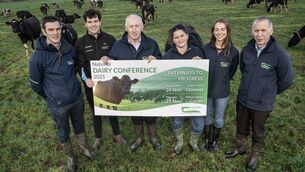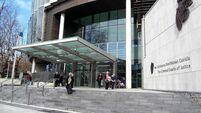A difficult balancing act for milk producers
But how can we increase our milk supply by 50% by 2020 and still meet national targets for reducing greenhouse gases 20%, also by 2020?
This question was central to a conference on ‘Towards a Sustainable Dairy Sector’ organised by the Society of Dairy Technology (a professional body for managers and researchers in dairy processing) in UCC recently.
Emissions from agriculture decreased by 0.35m tonnes (1.9%) in 2011 — attributed by the EPA to a 4.7% decrease in nitrogen fertiliser use, and a 5.9% decrease in diesel use on farms.
Teagasc research findings, presented at the conference by Rogier Schulte, show where the gas emissions arise, along the dairy production chain. A very large share arises on livestock farms, with the methane emitted by belching bovines the largest component. And fingers can be pointed at agriculture as being “polluting” — because dairy and beef are so much more important in the Irish economy than in other countries (and heavy goods manufacturing is so small), and our low levels of emissions in the dairy and beef sectors still amount to a big share of our total greenhouse gas emissions.
No sectoral targets have been set for reduction in national greenhouse gas emissions. Significant volumes are produced in agriculture, energy, transport, industry, and in our homes.
Theoretically, a 20% reduction could be achieved, while still allowing agriculture to expand. But the projected 50% increase in milk production would involve an increase in greenhouse gas emissions from agriculture — even though the carbon intensity of agricultural production would decline (the increase is not substantial in comparison to the projected rise in agricultural output, due to ongoing gains in production efficiency and reductions in the GHG emissions per unit of agricultural produce).
Teagasc research has looked at all the sources of carbon, and estimated that a reduction can be economically achieved — economically, but not easily, because we are already carbon efficient.
Most of the measures that have potential are expected to simultaneously reduce greenhouse gas emissions and increase farm profitability, because they maximise output of produce per unit of farm input.
Examples include a continuing rise in the Economic Breeding Index (the single figure profit index which helps farmers identify the most profitable bulls and cows for breeding dairy herd replacements); extended grazing; and nitrogen efficiency.
Some other measures (such as use of biofuel) are not so attractive.
In general, efforts to improve efficiency are more effective than introduction of new technologies.
Opening the UCC conference, Agriculture Minister Simon Coveney said sustainability has moved from a moral point of view to a necessity for success in world trade.
More and more international food companies want to ensure that their supply chains are “sustainable”, and are auditing them to guarantee this.
We need to produce more from the same resources, or less resources.
While we in Ireland have low levels of greenhouse gas emissions, and a highly sustainable production system for beef and dairy products, it is necessary, as a tool of trade, to measure and certify this — and then boast about it.
Mr Coveney referred to the Origin Green scheme recently introduced by Bord Bia, for measuring the carbon footprint of the beef sector. He said this scheme would be extended soon to the dairy sector.
Mr Coveney said he has persuaded several other EU member states that the objective for the 2014 CAP reform should be wider than the European Commission’s predominant concern with biodiversity, and should include “sustainable expansion of food production”.
The wider challenge is that worldwide food production needs to increase by 70-100% by 2050 (to feed a population estimated to grow from 7-9bn, while also providing for those who are inadequately fed at present).
Meanwhile, greenhouse gas production needs to fall by 50% to 80%, also by 2050, to control climate change.
These challenges appear daunting. Although Ireland is not a major contributor to world greenhouse emissions, we are committed to reducing our level by 20% by 2020. And within Ireland, agriculture is a major contributor (32.1%) to emissions.
At UCC, Anne Randles from the Irish Dairy Board summarised the challenges for the world’s food industry:
* balancing future supply and demand at affordable prices.
* ensuring stable supplies and protecting the poor from price volatility.
* ending hunger.
* mitigating climate change.
There are other challenges: about 30% of food produced is never consumed, due mainly to inadequate infrastructure in the developing countries and substantial waste in homes in the developed world.
Demand for dairy products is growing faster than supply, driven by developing markets.
Prices are higher, but also much more volatile. Unpredictable weather events have become a feature, affecting supplies.
The consumer wants low-input dairy products which are grass based, and are otherwise environmentally friendly.









